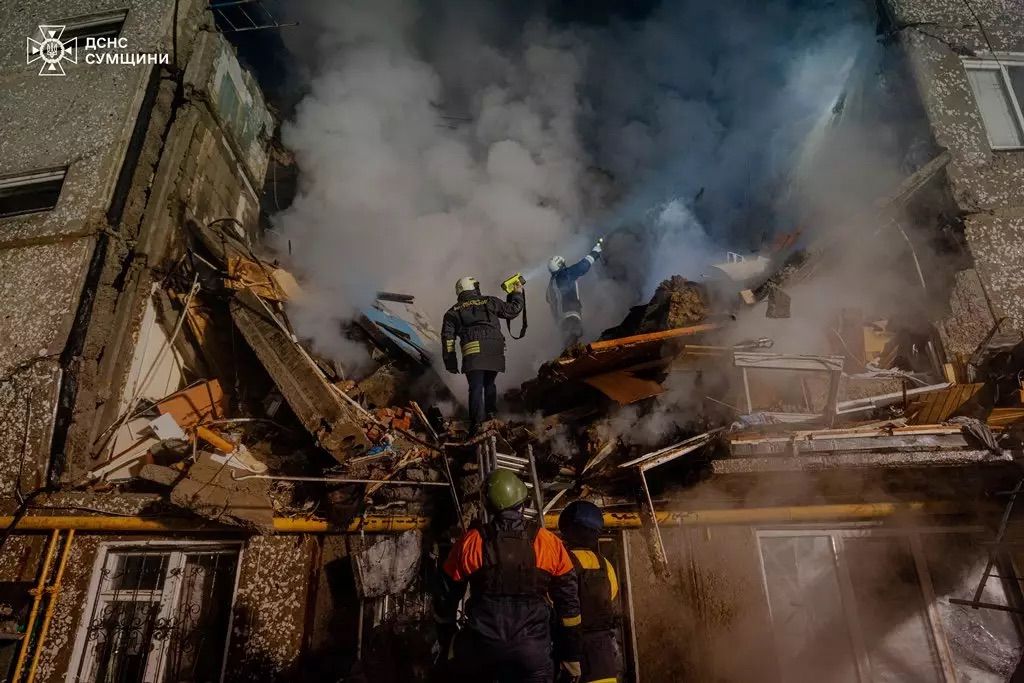Daily Flyer - March 29- 30, 2024
A voice of Ukraine to the West

Russia intensifies attacks on Kharkiv, draining Ukraine's air defense
On March 27, Russian forces launched a deadly attack on Kharkiv, utilizing a glide air bomb, marking the first such attack since 2022. The assault resulted in the death of a 59-year-old man and injuries to 19 others, including four children. Kharkiv, Ukraine's second-largest city, has been subjected to frequent attacks in recent weeks, with nearly ten strikes occurring within the last month alone. These attacks have caused substantial damage to civilian infrastructure and an increase in casualties among residents.
In response to the attack, President Volodymyr Zelensky called for increased assistance from Western allies, particularly in the form of air defense systems. However, experts note that proximity to the Russian border poses challenges to the effectiveness of such systems, as ground-based fire can still reach the city. To establish a truly secure zone, Russian forces must be pushed back at least 80-100 kilometers, allowing for the deployment of air defense systems like the Patriot. However, this poses logistical and strategic challenges, as such systems are not designed for close-range combat.
The recent attack on Kharkiv's energy infrastructure further underscores Russia's strategic objectives, aiming not only to disrupt critical services but also to undermine Ukrainian morale and military capabilities. Federico Borsari of the Center for European Policy Analysis highlights the potential impact on Ukraine's military operations, particularly its digitized command and control structure, which relies heavily on consistent power supply.
While some have dismissed reports of a new Russian offensive against Kharkiv, others believe that Russia may still attempt such a move in the coming months. Despite potential challenges, including ammunition shortages and Ukrainian defensive preparations, Russia's substantial troop presence in the region could facilitate a renewed offensive. However, skepticism remains about Russia's ability to mount a successful offensive, with some experts suggesting alternative targets and objectives in the near term.
Russian forces have seized 505 square kilometers since October offensive
Since the onset of Russia's latest offensive operation in October 2023, its forces have seized an area spanning 505 square kilometers, as reported by the Institute for the Study of War (ISW), a Washington-based think tank, in its latest assessment on March 28.
According to the ISW, between January 1 and March 28, Russian forces further expanded their territorial control by nearly 100 square kilometers. However, the ISW notes that this modest increase in the pace of Russian advancement does not reflect the potential threat of operational success, particularly in light of ongoing delays in US security assistance.
Material shortages have hampered Ukrainian forces' ability to mount effective defensive operations, while simultaneously providing Russian forces with the flexibility to pursue various offensive strategies. This situation, the ISW argues, creates opportunities for Russian forces to achieve significant operational gains in the future.
As long as material constraints persist and Ukraine grapples with manpower issues, the potential for exploiting Ukrainian vulnerabilities is expected to grow.
The ISW emphasizes that the provision of sufficient and regular Western security assistance, coupled with addressing Ukrainian manpower challenges, would mitigate these opportunities for Russian forces.
Lavrov dismisses Zelensky’s peace plan, says those pushing it are ‘not serious’
Russian Foreign Minister Sergey Lavrov has rejected Ukraine's peace plan, deeming it futile to demand the withdrawal of Russian troops from currently occupied areas.
"We are prepared to engage in discussions, but not based on (President Volodymyr) Zelensky's 'peace formula,'" Lavrov stated in an interview with the Moscow newspaper Izvestia, published on March 29.
Zelensky introduced the 10-point peace formula in November 2022, backed by numerous Western allies. The plan advocates for the restoration of Ukraine's territorial integrity, the complete withdrawal of Russian forces from Ukraine, and the release of all prisoners of war and deportees.
The proposals also include measures to hold accountable those responsible for war crimes, prevent ecocide in Ukraine, and ensure energy, food, and nuclear security. Lavrov questioned the assertion that there is no alternative to the Zelensky formula, suggesting it lacks seriousness.
Russia has already announced its refusal to participate in the Ukraine peace summit slated for Switzerland later this year, even if extended an invitation.
The summit aims to gather over 160 countries to discuss Kyiv's peace formula and draft a joint document outlining steps to restore the country's sovereignty.
Lavrov revealed discussions with Swiss officials who assured him of Russia's invitation, acknowledging the necessity of Russian involvement.
He criticized U.S. efforts to separate issues like arms deals from the conflict in Ukraine, dismissing them as laughable and indicative of diplomatic incompetence.
Lavrov's remarks underscore the ongoing diplomatic impasse and divergent perspectives on resolving the Ukraine crisis.
Russian attack on Kharkiv cannot be ruled out, according to commander-in-chief
Commander-in-Chief of Ukraine's Armed Forces Oleksandr Syrskyi stated on March 29 that any attempt by the Russian army to seize the city of Kharkiv would prove "fatal" for Moscow’s forces.
Kharkiv, Ukraine's second-largest city, has experienced an escalation in Russian strikes in recent weeks, including missiles, drones, and air bombs.
While reports suggest that a ground offensive against Kharkiv is not ruled out by some political elites, Syrskyi emphasized that Ukraine's Armed Forces are prepared to respond adequately to such a possibility. He highlighted ongoing efforts to fortify territories and positions, including the installation of a complex system of barriers.
Referring to the liberation of parts of Kharkiv Oblast in 2022 after seven months of Russian occupation, Syrskyi noted Ukraine’s Armed Forces' experience in military operations in the region, which led to the "large-scale collapse of the Russian front."
Syrskyi asserted that if Russian forces attempt another incursion, Kharkiv would become a deadly city for them.
Despite facing numerical and technological disadvantages, Ukraine leverages drones and high-precision artillery, making Russian troops vulnerable even far from the front lines.
Acknowledging the challenging situation on the front, Syrskyi noted Moscow’s forces' use of mass assaults and increased air strikes and guided bombs targeting Ukrainian positions.
Regarding ammunition, Syrskyi mentioned a disadvantage of around 6:1 in favor of Russian forces but highlighted Ukraine's utilization of high-precision ammunition to target enemy concentrations even tens of kilometers from the front line.
Russia targets Kaniv, Dnister hydroelectric power plants overnight
Russian troops carried out attacks on the Kaniv Hydroelectric Power Plant in Cherkasy Oblast and the Dnister Hydroelectric Power Plant in Chernivtsi Oblast on March 29, as confirmed by President Volodymyr Zelensky.
The overnight assault targeted energy and civilian infrastructure across 10 regions of Ukraine, injuring at least six people, including a child, according to Interior Minister Ihor Klymenko.
DTEK, Ukraine's largest private energy company, reported that three of its power plants sustained serious damage in the attack. Air Force Commander Mykola Oleshchuk stated that Ukrainian forces successfully intercepted 84 out of the 99 Shahed-type drones and missiles deployed in the assault.
Zelensky denounced the attacks on the hydroelectric power plants as deliberate acts by Russian forces, drawing parallels to the Kakhovka dam destruction in June 2023 and warning of threats extending beyond Ukraine's borders, particularly to Moldova.
The Dnister Hydroelectric Power Plant, situated near the Ukrainian-Moldovan border, raised concerns about potential spillover into Moldovan airspace during the attack, although Kyiv could not verify this information, according to Air Force spokesperson Illia Yevlash.
The assault on March 22 on the Dnipro Hydroelectric Power Plant, Ukraine's largest, further underscores the targeting of critical energy infrastructure by Russian forces.
Romania, which shares borders with western Ukrainian regions and Odesa Oblast in the south, reported finding alleged drone fragments near its border with Ukraine, as per the Defense Ministry's announcement on March 29.
The Hydroelectric Power Station-2 (HPS-2) of Zaporizhzhia's Dnipro Hydroelectric Power Plant is now in a critical state following the attack, with damage to the dam itself. However, officials assured that there was no imminent risk of a breach.
Russia attacks nine communities in Sumy Oblast

Russian forces launched attacks on nine border areas and settlements in Sumy Oblast on March 29, unleashing a barrage of 25 assaults resulting in at least 92 explosions, as reported by the Sumy Oblast Military Administration.
The communities of Khotin, Bilopillia, Myropillia, Krasnopillia, Velyka Pysarivka, Esman, Seredyna-Buda, Znob-Novhorodske, and Kyrykivka were targeted in the onslaught.
Utilizing artillery fire, aerial bombing, drone attacks, mortar shelling, and mine drops, the Russian military subjected these communities to a relentless assault.
Fortunately, there were no reported casualties or injuries resulting from the attacks. However, the town of Myropillia, with a pre-war population of approximately 4,500 residents, bore the brunt of the assault, experiencing 29 explosions, while Khotin witnessed 24 explosions.
Residents of Sumy Oblast have been enduring daily threats of shelling, but the recent escalation in attacks has prompted significant evacuations from the region.

